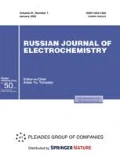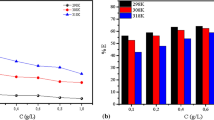Abstract
Some pharmaceutical compounds namely valsartan, hydrocholorothiazide, erythromycin thiocynate and diclofenac potassium were studied as chemical additions for enhancing the finished C-steel surface attained. Anode potential–limiting current relationship was measured and comparing of gradually increasing pharmaceutical compound concentrations (1 × 10–4–7 × 10–4 M) and weight loss method. C‑steel dissolution behavior in presence of pharmaceutical compounds was studied under natural convection and (rotating cylinder (RCE) and rotating disc electrode (RDE) as forced convection. The rotation speed of RCE and RDE was studied. The limiting current was found to diminishes with enlarging additives concentration and increase with increasing temperature (293–313 K). Activation energies values confirm that reaction rate was diffusion controlled. Results showed that the improvement produced in electropolishing in presence of pharmaceutical compounds occurs through adsorption of their molecules above metal surface. Pharmaceutical compound adsorption obey kinetic–thermodynamic model. Retardation percentage obtained from weight loss measurement are comparable with those obtained from galvanostatic polarization measurements. The data under different conditions were controlled by dimensionless correlations Sherwood (Sh), Schmidt (Sc) and Reynolds (Re) numbers. Surface morphology study confirmed that addition of pharmaceutical compound to C-steel dissolution bath enhance surface appearance and its texture quality to great extent.












Similar content being viewed by others
REFERENCES
Eliaz, N. and Nissan, O., Innovative processes for electropolishing of medical devices made of stainless steels, J. Biomed. Mater. Res., 2007, vol. 83, p. 546.
Deyab, M.A., Corrosion inhibition of heat exchanger tubing material (titanium) in MSF desalination plants in acid cleaning solution using aromatic nitro compounds, Desalination, 2018, vol. 439, p. 73.
El-Rabiee, M.M., Helal, N.H., Abd El-Hafez, Gh.M., and Badawy, W.A., Corrosion control of vanadium in aqueous solution by amino acids, J. Alloy. Compd., 2008, vol. 459, p. 466.
Khun, N.W., Sumption, M., and Frankel, G.S., Smoothening of niobium by electropolishing, J. Appl. Electrochem., 2013, vol. 43, p. 829.
Zhao, X., Corcoran, Se.G., and Kelley, M.J., Sulfuric acid-methanol electrolytes as an alternative to sulfuric-hydrofluoric acid mixtures for electropolishing of niobium, J. Appl. Electrochem., 2011, vol. 41, p. 633.
Dhavale, A.S., Ciovati, G., and Myneni, G.R., Symposium on the superconducting science and technology of ingot niobium, AIP Conf. Proc., 2011, vol. 1352, p. 119.
Huo, J., Solanki, R., and Mcandrew, J., Study of anodic layers and their effects on electropolishing of bulk and electroplated films of copper, Electrochemistry, 2004, vol. 34, p. 305.
Abdel-Rahman, H.H., Hafez, A.M., and Helmy, A.A., Physicochemical study on the effectiveness of eco-friendly anti-corrosion agent on the corrosion of steel in H3PO4 solution, Electrochemistry, 2015, vol. 83, p. 440.
Abdel-Rahman, H.H., Seleim, S.M., Hafez, A.M., and Helmy, A.A., Study of electropolishing inhibition of steel using natural products as a green inhibitor in ortho-phosphoric acid, Green Chem. Lett. Rev., 2015, vol. 8, p. 88.
Abouzeid, F.M., Comparison between electropolishing behavior of copper and mild steel in the presence of lactic and mandolic acid, Int. J. Electrochem. Sci., 2016, vol. 11, p. 7269.
Abouzeid, F.M., Surface active properties of gelatin and their effect on the electropolishing behavior of steel in orthophosphoric acid, Egypt.J. Pet., 2016, vol. 25, p. 229.
Abouzeid, F.M., Morphology and optical properties of electropolished steel in presence of vitamin C, Asian J. Chem., 2016, vol. 28, p. 743.
Fouda, A.S., Al-Sarawy, A.A., Ahmed, F.Sh., and El‑Abbasy, H.M., Corrosion inhibition of aluminum 6063 using some pharmaceutical compounds, Corros. Sci., 2009, vol. 51, p. 485.
Eddy, N.O. and Ebenso, E.E., Adsorption and quantum chemical studies on cloxacillin and halides for the corrosion of mild steel in acidic medium, Int. J. Electrochem. Sci., 2010, vol. 5, p. 731.
Abdallah, M., Antibacterial drugs as corrosion inhibitors for corrosion of aluminum in hydrochloric acid solution, Corros. Sci., 2004, vol. 46, p. 1981.
Morad, M.S., Inhibition of iron corrosion in acid solutions by cefatrexyl: behaviour near and at the corrosion potential, Corros. Sci., 2008, vol. 50, p. 436.
Karthik, G. and Sundaravadivelu, M., Studies on the inhibition of mild steel corrosion in hydrochloric acid solution by atenolol drug, Egypt.J. Pet., 2016, vol. 25, p. 183.
Taha, A.A., Abdel Rahman, H.H., and Abouzeid, F.M., Effect of surfactants on the rate of diffusion controlled anodic dissolution of copper in orthophosphoric acid, Int. J. Electrochem. Sci., 2013, vol. 8, p. 6751.
Taha, A.A., Abdel Rahman, H.H., Ahmed, A.M., and Abouzeid, F.M., A study of factors influencing on dissolution behavior of copper in orthophosphoric acid using rotating cylinder electrode (RCE) and rotating disc electrode (RDE), Int. J. Electrochem. Sci., 2013, vol. 8, p. 9041.
Taha, A.A., Ahmed, A.M., Abdel Rahman, H.H., and Abouzeid, F.M., The effect of surfactants on the electropolishing behavior of copper inorthophosphoricacid, Surf. Sci., 2013, vol. 277, p. 159.
Adejoro, I.A., Ojo, F.K., and Obafemi, S.K., Corrosion inhibition potentials of ampicillin for mild steel in hydrochloric acid solution, J. Taibah Univ. Sci., 2015, vol. 9, p. 196.
Loto, R.T., Loto, C.A., Joseph, O., and Olanrewaju, G., Adsorption and corrosion inhibition properties of thiocarbanilide on the electrochemical behaviour of high carbon steel in dilute acid solutions, Res. Phys., 2016, vol. 6, p. 305.
Abdallaha, M., Zaafaranya, I.A., and Al Jahdaly, B.A., Corrosion inhibition of zinc in hydrochloric acid using some antibiotic drugs, J. Mater. Environ. Sci., 2016, vol. 7, p. 1107.
Bammou, L., Belkhaouda, M., Salghi, R., Benali, O., Zarrouk, A., Zarrok, H., and Hammouti, B., Corrosion inhibition of steel in sulfuric acidic solution by the extracts, J. Assoc. Arab Univ. Basic Appl. Sci., 2016, vol. 16, p. 83.
Deyab, M.A. and Taiwan, .J., Corrosion inhibition of aluminum in biodiesel by ethanol extracts of Rosemary leaves, Inst. Chem. Eng., 2016, vol. 58, p. 536.
Umoren, S.A., Eduok, U.M., Solomon, M.M., and Udoh, A.P., Corrosion inhibition by leaves and stem extracts of Sida acuta for mild steel in 1 M H2SO4 solutions investigated by chemical and spectroscopic techniques, Arab. J. Chem., 2016, vol. 9, p. 209.
Deyab, M.A., Egyptian licorice extract as a green corrosion inhibitor for copper in hydrochloric acid solution, Chem. Res., 2015, vol. 22, p. 384.
Afolabi, A.S., Muhirwa, A.C., Abdulkareem, A.S., and Muzenda, E., Weight loss and microstructural studies of stressed mild steel in apple juice, Int. J. Electrochem. Sci., 2014, vol. 9, p. 5895.
Lahhit, N., Bouyanzer, A., and Desjobert, J., Fennel (Foeniculum Vulgare) essential oil as green corrosion inhibitor of carbon steel in hydrochloric acid solution, Port Electrochim. Acta, 2011, vol. 29, p. 127.
Li, L., Qu, Q., Bai, W., Yang, F., Chen, Y., Zhang, S., and Ding, Z., Sodium diethyldithiocarbamate as a corrosion inhibitor of cold rolled steel in 0.5 M hydrochloric acid solution, Corros. Sci., 2012, vol. 59, p. 249.
Javadian, S., Darbasizadeh, B., Yousefi, A., Ektefa, F., Dalir, N., and Kakemam, J., Dye-surfactant aggregates as corrosion inhibitor for mild steel in NaCl medium: experimental and theoretical studies, J. Taiwan. Inst. Chem. Eng., 2017, vol. 71, p. 344.
Abd El-Lateef, H.M., Soliman, K.A., and Tantawy, A.H., Novel synthesized Schiff base-based cationic gemini surfactants: electrochemical investigation, theoretical modeling and applicability as biodegradable inhibitors for mild, J. Mol. Liq., 2017, vol. 232, p. 478.
Landolt, D., Fundamental aspects of electropolishing, Electrochim. Acta, 1987, vol. 32, p. 1.
Martínez, R.G., Flores, J.M., Romero, R.D., and Llongueras, J.G., Rotating cylinder electrode study on the influence of turbulent flow, on the anodic and cathodic kinetics X52 steel corrosion, in H2S containing solutions, Afinidad, 2005, vol. 62, p. 448.
Abdel-Aziz, M.S.M., El-Shazly, A.H., Faraand, H.A., and Sedahmed, G.H., Mass transfer behavior of rotating square cylinder electrochemical reactor in relation to wastewater treatment, Energy Convers. Manag., 2011, vol. 52, p. 2870.
Bilson,M. and Bremhorst, K., Comparison of turbulent scalar transport in a pipe and a rotating cylinder, Proc. 3rd Int. Conf. on CFD in the Minerals and Process Industries. CSIRO, Melbourne, Dec. 10–12, 2003.
ACKNOWLEDGMENTS
We thank scanning electron microscope unit in faculty of science—Alexandria University for its cooperation with us in surface characterization.
Author information
Authors and Affiliations
Corresponding author
Ethics declarations
NOTES
Compliance with ethical standards.
CONFLICT OF INTEREST
The authors declare that they have no conflict of interest.
Compliance with standards of research involving animals.
This article does not contain any studies involving animals performed by any of the authors.
Compliance with standards of research involving humans as subjects.
This article does not contain any studies involving human participants performed by any of the authors.
Rights and permissions
About this article
Cite this article
Taha, A.A., Abouzeid, F.M. & Kandil, M.M. Some Drugs Effect on the Electropolishing of C-Steel in H3PO4 Acid under Normal and Compulsory Convection Circumstances. Russ J Electrochem 56, 189–205 (2020). https://doi.org/10.1134/S102319352003012X
Received:
Revised:
Accepted:
Published:
Issue Date:
DOI: https://doi.org/10.1134/S102319352003012X




